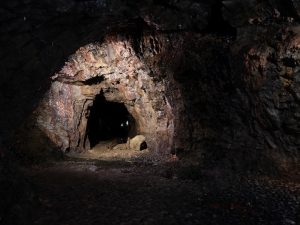Malte J. M. Gurgel, M. Sc. | Univ.-Prof. Dr.-Ing. Axel Preuße
September 2021
Modern, integrated methods are increasingly being used for the three-dimensional acquisition of underground cavities. In addition to active methods such as LiDAR, photogrammetric methods like Structure from Motion (SFM) could provide significant value for image-based visualization.
Ongoing research at the Institute for Mine Surveying, Mining Subsidence Engineering and Geophysics in Mining at RWTH Aachen University is dealing with the implementation of high-resolution and survey-precise cavity registration for planning, decision-making and visualization purposes, by providing georeferenced point clouds and meshed 3D models. The research is carried out as a funded doctoral project by Malte J. M. Gurgel.
Backgrounds of photogrammetry and structure from motion
In the past, cavities were mostly surveyed using conventional methods and instruments such as levelling devices, theodolites, or total stations by measuring individual, discrete points.
Modern methods such as photogrammetry or LiDAR enable the complete three-dimensional mapping of a cavity. While active methods like LiDAR scan the cavity, photogrammetry works passively. For this purpose, acquired measurement images are aligned to each other. The mathematical-geometrical description of the relative position and orientation in object space is called a photogrammetric model.
New methods like structure from motion allow this image alignment process to be performed largely without ground control points, since common image areas can be reliably detected automatically using feature extraction and feature matching algorithms. In further processing steps, the oriented measurement images can be used to generate dense point clouds and high-resolution, textured 3D models.
Research at Institute for Mine Surveying
The current research focuses mainly on the development of an integrated capturing system based on Structure from Motion, which meets the increased requirements of underground cavities. The harsh operational conditions, difficult lighting situation, and the lack of satellite-based localization capabilities require further research for such an operational environment.
Suitable geo-referencing options as well as an initial assessment of the achievable accuracy in the single-digit centimeter range were undertaken as part of a 2019 master’s thesis. (see Fig.1)

Fig. 1. Generated dense point cloud of parts the RWTH Aachen University’s mining building. (Gurgel and Preusse, 2021, see [2])
Another case study is now being evaluated based on data acquired in the former lead ore mine “Grube Wohlfahrt” in the German Eifel region. In this context, data fusion of different acquisition methods and ways of clear visualization using augmented reality are investigated. Fig. 2 shows a point cloud generated by Structure from Motion in the above-mentioned mine.

Fig. 2. Detail view of a dense point cloud of former lead ore mine “Grube Wohlfahrt” in German Eifel region. (Gurgel and Preusse, 2021)
Further research is addressing the following topics:
- Implementation of robust geo-referencing
- Options for a structured accuracy estimation (for single-sensor and multi-sensor acquisition systems)
- 4D visualization of cavities that are subject to dynamic changes (monitoring)
Benefits of a 3-D cavity registration and possible use cases for Indonesia
The described methodology can in principle be used for a wide range of applications. Detection and monitoring of underground cavities is of great interest for active mining operations as well as for possible post-utilization concepts. In Germany, several research projects are currently looking for sites in existing or newly created underground cavities for storing energy and different media.
Such a three-dimensional survey could also be considered for other cavities, such as natural caves or other underground facilities related to water supply.
These models could be used, for example, to generate a comprehensive description of the cavity geometry as well as to determine precise values for volumes or cross-sections, e.g., to answer hydrogeological questions related to subsurface discharge systems.
Besides the wide range of applications, photogrammetric methods offer the great advantage that the evaluation process is detached from the image acquisition. This means that the image evaluation can be performed again at a later time with more powerful hardware and software and without having to acquire new image material. The original material is thus preserved for further research and can continue to be used for qualitative assessment, like characterization of surface texture.
A future extension of this research to Indonesian case studies is therefore seen as promising.
Selected recent publication
Specific aspects of integrated cavity registration have been discussed in the following selected publications and conference papers:
- Gurgel, M. J. M. and Preusse, A. “Concept of an Integrated Capture and Evaluation Approach for a Georeferenced Visualization of Underground Cavities“. In: Proceedings of the 40th International Conference on Ground Control in Mining. Ed. by Klemetti, T. et al. Society for Mining, Metallurgy & Exploration (SME), 2021.
- Gurgel, M. J. M. and Preusse, A. “New opportunities and challenges in surveying underground cavities using photogrammetric methods”. International Journal of Mining Science and Technology, Volume 31, Issue 1, 2021, Pages 9-13, ISSN 2095-2686, DOI: https://doi.org/10.1016/j.ijmst.2020.12.005.
Contact
Malte J. M. Gurgel, M. Sc. (gurgel@ifm.rwth-aachen.de)
Univ.-Prof. Dr.-Ing. Axel Preuße (preusse@ifm.rwth-aachen.de)
Institute for Mine Surveying, Mining Subsidence Engineering and Geophysics in Mining
(IFM)
RWTH Aachen University
Wuellnerstr. 2
52062 Aachen
Germany
